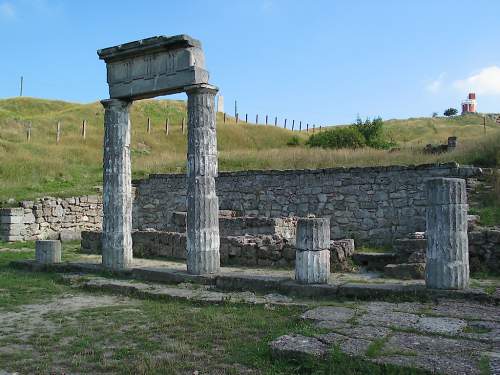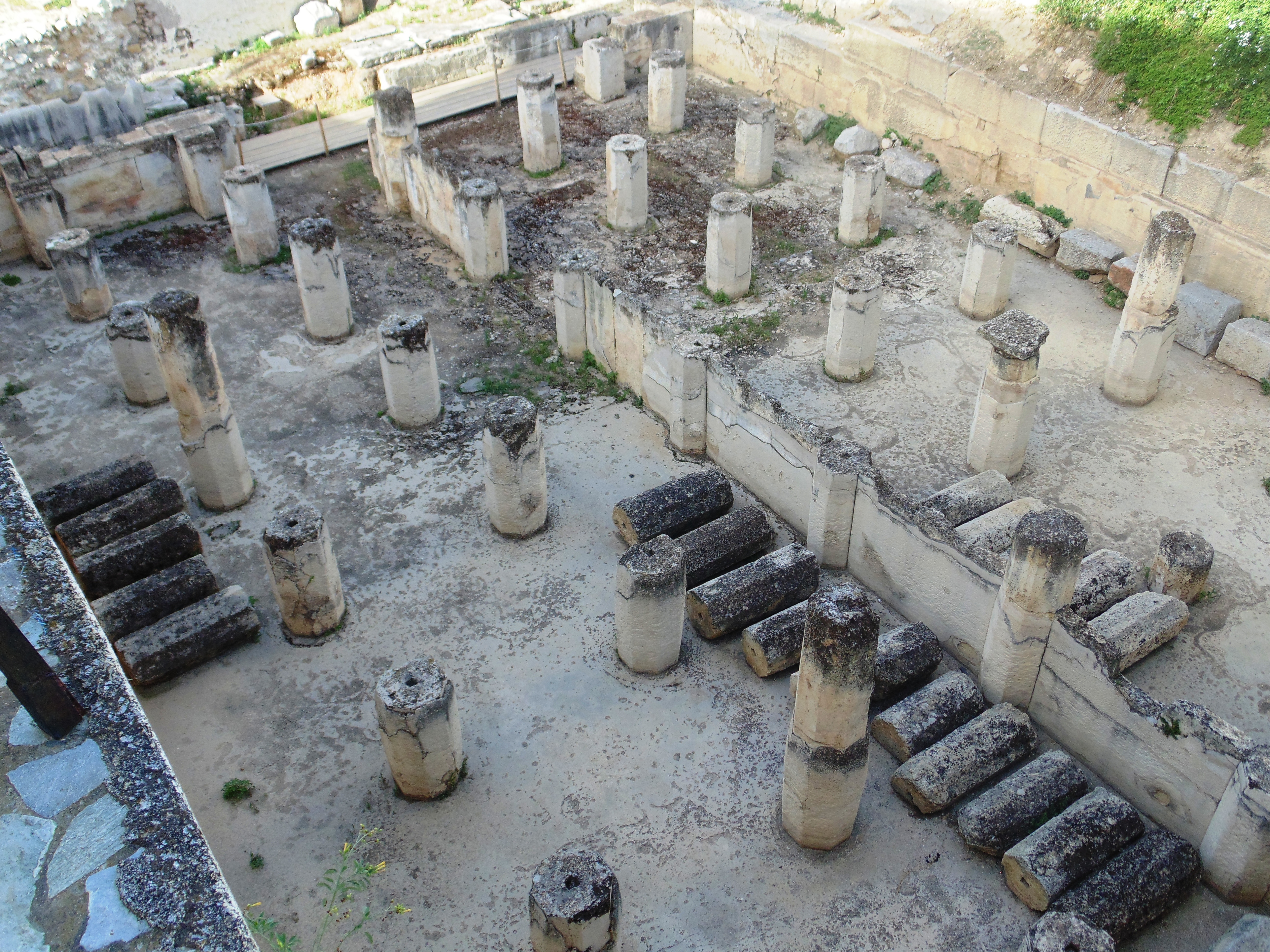|
Pantikapaion
Pantikapaion ( , from Scythian 'fish-path'; ) was an ancient Greek city on the eastern shore of Crimea, which the Greeks called Taurica. The city lay on the western side of the Cimmerian Bosporus, and was founded by Milesians in the late 7th or early 6th century BC, on a hill later named Mount Mithridat. Its ruins now lie in the modern city of Kerch. Early existence During the first centuries of the city's existence, imported Greek articles predominated: pottery (see Kerch Style), terracottas, and metal objects, probably from workshops in Rhodes, Corinth, Samos, and Athens. Local production, imitated from the models, was carried on at the same time. Athens manufactured a special type of bowl for the city, known as Kerch ware. Local potters imitated the Hellenistic bowls known as the Gnathia style as well as relief wares— Megarian bowls. The city minted silver coins from the 5th century BC and gold and bronze coins from the 4th century BC.Sear, David R. (1978). ''Greek Coi ... [...More Info...] [...Related Items...] OR: [Wikipedia] [Google] [Baidu] |
Kerch
Kerch, also known as Keriç or Kerich, is a city of regional significance on the Kerch Peninsula in the east of Crimea. It has a population of Founded 2,600 years ago as the Colonies in antiquity#Greek colonies, ancient Greek colony Pantikapaion, Kerch is one of the most ancient cities in Crimea. The city experienced rapid growth starting in the 1920s and was the site of Battle of the Kerch Peninsula, a major battle during World War II. Today, it is one of the largest cities in Crimea and is among the area's most important industrial, transport and tourist centres. As with the rest of Crimea, it has been occupied by Russian forces since the Annexation of Crimea by the Russian Federation, Russian annexation of Crimea in 2014. History Ancient times Archeological digs at Mayak village near the city ascertained that the area had already been inhabited in the 17th–15th centuries BC. While many finds from Kerch can be found in the Hermitage Museum in St Petersburg and the loc ... [...More Info...] [...Related Items...] OR: [Wikipedia] [Google] [Baidu] |
Scythian Languages
The Scythian languages are a group of Eastern Iranic languages of the classical and late antique period (the Middle Iranic period), spoken in a vast region of Eurasia by the populations belonging to the Scythian cultures and their descendants. The dominant ethnic groups among the Scythian-speakers were nomadic pastoralists of Central Asia and the Pontic–Caspian steppe. Fragments of their speech known from inscriptions and words quoted in ancient authors as well as analysis of their names indicate that it was an Indo-European language, more specifically from the Iranic group of Indo-Iranic languages. Most of the Scythian languages eventually became extinct, except for modern Ossetian (which descends from the Alanic dialect of Scytho-Sarmatian), Wakhi (which descends from the Khotanese and Tumshuqese forms of Scytho-Khotanese), and Yaghnobi (which descends from Sogdian). Alexander Lubotsky summarizes the known linguistic landscape as follows: Classification ... [...More Info...] [...Related Items...] OR: [Wikipedia] [Google] [Baidu] |
Prytaneion
A ''prytaneion'' (, ) was seat of the ''prytaneis'' (Executive (government), executive), and so the seat of government in ancient Greece. The term is used to describe any of a range of ancient structures where officials met (normally relating to the government of a city), but the term is also used to refer to the building where the officials and winners of the Olympic Games met at Olympia, Greece, Olympia. The ''prytaneion'' normally stood in the centre of the city, in the agora. In general in ancient Greece, each state, city or village possessed its own central hearth and sacred fire, the ''prytaneion'', representing the unity and vitality of the community. The fire was kept alight continuously, tended by the king or members of his family. The building in which this fire was kept was the ''prytaneion'', and the chieftain (the king or ''prytanis'') probably made it his residence. The building contained the holy fire of Hestia, the goddess of the hearth, and symbol of the life of t ... [...More Info...] [...Related Items...] OR: [Wikipedia] [Google] [Baidu] |
Thracian
The Thracians (; ; ) were an Indo-European speaking people who inhabited large parts of Southeast Europe in ancient history.. "The Thracians were an Indo-European people who occupied the area that today is shared between north-eastern Greece, Romania, and north-western Turkey. They shared the same language and culture. There may have been as many as a million Thracians, divided among up to 40 tribes." Thracians resided mainly in Southeast Europe in modern-day Bulgaria, Romania, North Macedonia, northern Greece and European Turkey, but also in north-western Anatolia (Asia Minor) in Turkey. The exact origin of the Thracians is uncertain, but it is believed that Thracians like other Indo-European speaking groups in Europe descended from a mixture of Proto-Indo-Europeans and Early European Farmers. Around the 5th millennium BC, the inhabitants of the eastern region of the Balkans became organized in different groups of indigenous people that were later named by the ancient G ... [...More Info...] [...Related Items...] OR: [Wikipedia] [Google] [Baidu] |
Spartocids
The Spartocids () or Spartocidae was the name of a Hellenized Thracian dynasty that ruled the Hellenistic Kingdom of Bosporus between the years 438–108 BC. They had usurped the former dynasty, the Archaeanactids, who were tyrants of Panticapaeum from 480 to 438 BC. The throne of the Bosporan Kingdom was usurped by Spartokos I in 438 BC, after whom the dynasty is named. Spartokos's descendants would continue to rule the Bosporus until 108 BC, in which it was briefly conquered by the invading Scythians led by Saumacus and subsequently ruled by the Mithridatic and Tiberian-Julian dynasties. The dynasty continued to repeat the names of succeeding princes, with the final Spartokos being named Spartokos V. The dynasty also had intermarriages, notably the marriage of Komosarye and Paerisades I. The most famous known ruler is Leukon I, who expanded the kingdom beyond its boundaries, resisted the Scythians, and ruled for 40 years. History The Spartocids are thought to be o ... [...More Info...] [...Related Items...] OR: [Wikipedia] [Google] [Baidu] |
Archaeanactids
The Archaeanactids () were presumably a Greek dynasty of the Kingdom of Bosporus that ruled in 480–438 BC. The presumed founder, Archaeanax, was probably a strategos of a league of city-states in the Cimmerian Bosporus, likely formed as a defense against foreign threats. After taking power, Archaeanax caused the cities of Theodosia and Nymphaeum to withdraw from the league. Throughout their reign, Panticapaeum and her surrounding cities had an age of economic growth as well as the construction of new temples and replanning of all city parts. They were later succeeded by a hellenized family of Thracians, called the Spartocids The Spartocids () or Spartocidae was the name of a Hellenized Thracian dynasty that ruled the Hellenistic Kingdom of Bosporus between the years 438–108 BC. They had usurped the former dynasty, the Archaeanactids, who were tyrants of Pantic .... References 480 BC Ancient Greek dynasties Monarchs of the Bosporan Kingdom 5th-century BC estab ... [...More Info...] [...Related Items...] OR: [Wikipedia] [Google] [Baidu] |
Pan Compilation
Pan or PAN may refer to: Food * Pan (cooking), a piece of cooking equipment * Harina P.A.N., a pre-cooked corn meal * Pan or Paan, a North Indian term for betel Prefix * ''Pan-'', a prefix meaning "all", "of everything", or "involving all members" of a group People * Pan (surname), Chinese family name (潘 or 盤) * Pen Ran (), Cambodian singer and songwriter whose name is sometimes Romanized as Pan Ron Arts, entertainment, and media Card games * Pan (game), a shedding card game of Polish origin * Panguingue or Pan, a gambling card game Fictional characters * Pan (''Dragon Ball''), in ''Dragon Ball'' media * Peter Pan, created by James Barrie Films * ''Pan'' (1922 film), Norwegian film * ''Pan'' (1995 film), a Danish/Norwegian/German film * ''Pan'' (2015 film), film Literature and publishing * ''Pan'' (novel), by Knut Hamsun * ''Pan'' (magazine) an arts and literary review * Pan Books, a publisher Music Musical instruments * Pan, short for steelp ... [...More Info...] [...Related Items...] OR: [Wikipedia] [Google] [Baidu] |
Hermitage Museum
The State Hermitage Museum ( rus, Государственный Эрмитаж, r=Gosudarstvennyj Ermitaž, p=ɡəsʊˈdarstvʲɪn(ː)ɨj ɪrmʲɪˈtaʂ, links=no) is a museum of art and culture in Saint Petersburg, Russia, and holds the largest collection of paintings in the world. It was founded in 1764 when Empress Catherine the Great acquired a collection of paintings from the Berlin merchant Johann Ernst Gotzkowsky. The museum celebrates the anniversary of its founding each year on 7 December, Saint Catherine's Day. It has been open to the public since 1852. ''The Art Newspaper'' ranked the museum 10th in their list of the List of most visited art museums, most visited art museums, with 2,812,913 visitors in 2022. Its collections, of which only a small part is on permanent display, comprise over three million items (the numismatics, numismatic collection accounting for about one-third of them). The collections occupy a large complex of six historic buildings along Palace ... [...More Info...] [...Related Items...] OR: [Wikipedia] [Google] [Baidu] |
Megara
Megara (; , ) is a historic town and a municipality in West Attica, Greece. It lies in the northern section of the Isthmus of Corinth opposite the island of Salamis Island, Salamis, which belonged to Megara in archaic times, before being taken by Athens. Megara was one of the four districts of Attica, embodied in the four mythic sons of King Pandion II, of whom Nisos was the ruler of Megara. Megara was also a trade port, its people using their ships and wealth as a way to gain leverage on armies of neighboring poleis. Megara specialized in the exportation of wool and other animal products including livestock such as horses. It possessed two harbors, Pagae to the west on the Corinthian Gulf, and Nisaea to the east on the Saronic Gulf of the Aegean Sea. History Late Bronze Mycenaean period In the Late Bronze Age, Megara features prominently as a small kingdom in the myths and legends of Homer. Megara emerged between two fortified ports, Nisaea on the Saronic Gulf and Pagae on the ... [...More Info...] [...Related Items...] OR: [Wikipedia] [Google] [Baidu] |




